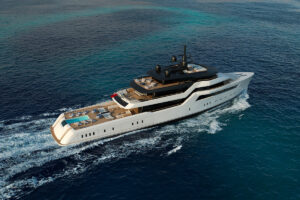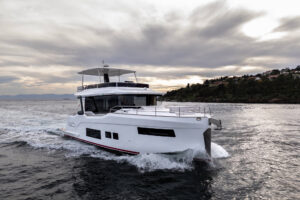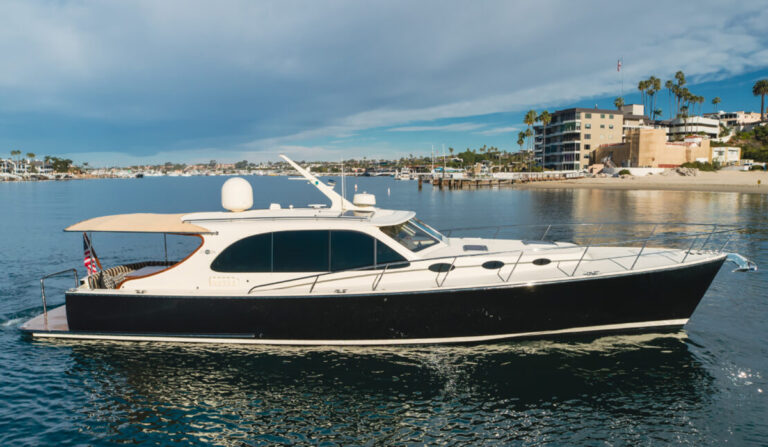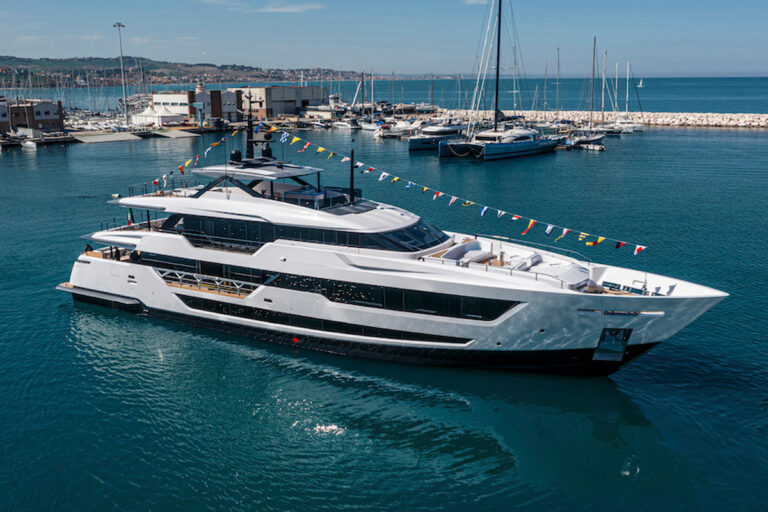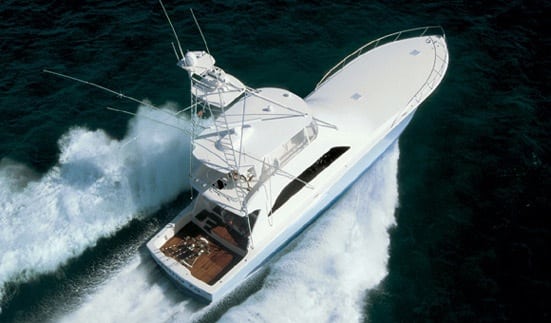
viking-74
For race car nuts, it’s the 24 hours at Le Mans. For big-game fishermen, it’s the five tournaments that make up the annual Bahamas Billfish Tournament. Ever since 1973 when Bimini, Cat Cay, Chub Cay and Walker’s Cay created the first Bahamas Billfish Championship, the best sportfishermen have been coming to the Bahamas each spring with the latest in depth sounders, radars, underwater cameras, infrared, high-speed engines, and all the design tricks money can buy. No wonder last year’s championship saw record numbers of fish hooked: In the five events 383 billfish were caught compared with 301 in 2004 (only nine of them were weighed in; the rest were released). You might think the fish have gotten stupider. Not true: boatbuilders and their fishing clients have just gotten smarter.
The real catches of the day? These six boats.
1. OUTLAW: With Eyes in the Back of Its Head
Randy Cook, owner of the 65-foot Outlaw from American Custom Yachts, caught so many fish last year you might think he could see underwater. And he could. Cook, the overall winner of the Treasure Cay Championship had Outlaw outfitted with more cameras than you might find at a Hollywood premiere. Four video cameras-two on the outriggers, one in the cockpit and a submersible camera on a pole-record all the action above and below the surface. There’s even a remote-controlled infrared camera on the hardtop that provides a daylight-like view of the water in pitch darkness.
Cook, who makes parts for surgical tools, counts himself as one of only 60 to 80 anglers who consistently fish the international tournament circuit. His 2006 itinerary includes Costa Rica (where Cook has a home), San Andreas (Colombia), Isla Mujeres (Mexico), the Bahamas, the Dominican Republic, St. Thomas, Tortola and the eastern Caribbean.
Cook prides himself on being able to run a yacht himself. So when it came time to find a new boat, he knew exactly what he wanted. “Some builders, like Merritt and Rybovich, wanted to build me a boat with a teak bulkhead, which I didn’t want,” says Cook. “Garlington didn’t have what I wanted at the time. It came down to Jim Smith and American. I saw the American 58 Terminator, and the search was over.”
This 65-foot, green-hulled speedster from American Custom Yachts took almost three years to build and was launched in 2003. “Almost everything on the boat was our design,” says Cook. “For instance, it’s the first American custom with a mezzanine deck. The day head was also our idea.” Outlaw has three staterooms and four heads. “This is a different 65,” notes Cook. “It has the house of a 60, which gives us a smaller saloon, but much more volume forward. The master is as large as a 72’s.”
Outlaw has a number of other interesting touches. There are overhead A/C vents in the cockpit behind pull-down lights. A 48-inch TV rises out of the portside cabinetry. In the master, a TV drops out of the headliner. Tackle drawers have perforated, stainless steel bottoms. The mezzanine beverage locker is pitched forward so cans slide to the front for easy access. All galley appliances, including steamer, warming drawer and espresso maker are hidden behind high-gloss cherry. While topmost storage drawers have glass bottoms, the galley and head soles are of rare chestnut wood from Maine.
Powered by 1,400 hp Caterpillar diesels, Outlaw cruises at 30 to 35 knots and tops out close to 40. “This is one of the best head-sea boats made,” says Cook, who’s from Nokomis, Fla., just south of Sarasota. “When others pull back, we’re still at cruising speed.” And if you are first to the fish, you’re often first to the trophy.
2. DOUBLE DOG: Gentlemen, Start Your Engines!
During the Marsh Harbour legs of the BBC, home for Don McKinney, owner of the 66 Hines-Farley Double Dog, was on nearby Man-O-War Cay, where he and his wife, Rebecca, live part time. McKinney has been billfishing since his college days, and he’s chartered boats from Central America to Africa. “I’ve even dragged bait behind sailboats,” he says.
Occupied with his computer business, McKinney had time for only skiffs and center consoles. But he carried a picture of a Hines-Farley on the cover of his notebook, having befriended a member of the Hines family in California. “Three years ago, Rebecca said, ‘Enough is enough-when are you going to buy your boat?'”
McKinney’s boat is one of the finest sportfishing yachts available. And, with 1,600 hp 16V 2000 Detroits, one of the fastest. At the Custom Boat Shootout at Harbour Island, a Bimini start is traditional on the last day. Double Dog has won it three years running. “Nobody wants to race us,” says McKinney’s captain. Topping out at close to 45 knots, Double Dog leaves the competition in its wake, although Blank Check can run a close second.
Speed alone is not what recommended the Hines-Farley 66 to McKinney. “I liked the fact that it’s one of the better sea boats-it can handle conditions substantially rougher than a person can take. You can run all day long in six-foot seas at 40 knots and wind up black and blue, but the boat will be fine. It jumps right off the line and takes a skilled captain to control it. When we bought it three years ago, it was really hot, but other builders are catching up,” he says.
The layout is three staterooms, three heads; woodwork is Cuban mahogany, with panels both matched and butterflied. McKinney plans to fish St. Thomas and then the winter sailfish tournaments in Florida. He averages 15 tournaments a year.
3. VIKING 74: A Fuel’s Game
Speed isn’t the only thing that will catch you a big fish. It takes staying power and patience. Not to mention enough fuel so you don’t have to turn home just as the fish begin to bite. “The Viking 74 can make it from Marsh Harbour to Atlantic City, N.J., with a single fuel stop,” brags Viking’s executive president Pat Healey, noting that the 3,000 gallons of fuel give her a 500-plus-mile range at a cruising speed of 31 to 32 knots. Her 2,000 hp M91 MTUs push a top speed of 37 knots.
Owner John Bennett Sr. and his son John Jr. are serious about fishing. The Kansas City, Mo., native started big-game fishing in 1990 from a 42 Porto Fino in Walker’s Cay. He’s since owned two Oceans and a Viking 65. The Bennetts had their Viking 74 factory boat, the largest Viking ever, on display at Boat Harbour alongside production boats from such builders as Cabo, Riviera, Bertram and Hatteras.
“I shopped heavily before buying the 65, but I didn’t see enough of a benefit from a custom boat,” said John Sr. “There’s a very thin line between a custom boat and a Viking at this level, and I’m overwhelmed by the service that Viking offers between its New Gretna, N.J., and Palm Beach facilities.” As Healey noted, “Viking is a production builder, but we offer a lot of latitude in the boat’s layout and the arrangement; this boat also comes in a five-stateroom version.”
The Bennetts’ new 74, hull #8, has four staterooms and four heads. The day head is on the saloon level, which is a major plus. The master has twin double-door closets. “For its size it’s tremendously fishable,” says Bennett Sr. “I notice no difference from the 65. You won’t find a boat with this much interior room that runs and fishes in its league. The finish is magnificent. The technology is state-of-the-art.”
“We feel that we’re on the top of the production hill,” says Healey. “It took many years and a dedicated staff, but we’re totally committed to our owners. We have 40 engineers and 1,400 boat builders. We build a boat in 180 days-from 45 to 74 feet. This enables us to perfect our designs and installations and choose the right equipment.”
4. BLANK CHECK: Fun For the Family
Another father-son duo, Dan Doyle Sr. and his son, Dan Jr., also considered several custom boats before meeting Jim Weaver at a fishing tournament in Ocean City, Md. “My dad and I went on a Weaver 61 after a day of fishing and Jim started talking to us. We really hit it off, and within an hour we struck a deal. We needed a three-stateroom, three-head boat with a large saloon, so we ended up with a 68-footer. It took 18 months to build.”
They also wanted a fast boat and this Weaver 68 flies-43.6 knots top, 38 cruise-with 1,800 hp 2000-Series Detroit MTUs. Bowthruster controls are built into the throttle controls, and there’s a giant freezer on the bridge. The flat-screen TV on the saloon’s forward bulkhead swings up for access to the boat’s communications and entertainment systems. The three leather sofas in the saloon are overly wide so they can double as berths. “This can be a guy’s fishing boat one day and a family boat the next,” says Doyle.
Blank Check boasts the loveliest galley and head soles I’ve ever seen-cherry and wenge wood. Four refrigerator drawers and four freezer drawers surround the countertop, which retracts electrically to reveal the four-burner stove. A massive granite-topped island separates saloon and galley. “Just like at home, most of our entertaining revolves around the kitchen,” says Doyle.
The crew quarters has extra-wide berths, while the forward guest stateroom has double/single over-and-under berths designed “with kids in mind.” (Hey kids, there’s also a built-in Microsoft X-box!)
Linens are stored in natural cherry cabinets along the luxurious, curving portside companionway. A bird’s-eye maple ledge atop the lower cabinets is a striking accent. The master berth hinges up electrically for center storage access.
“It’s my son’s boat; I’m just along for the ride,” says Dan Sr., who lives in Tampa, Fla. The Doyles cruise the entire Caribbean and Dan Jr. will tell you that his favorite fishing ground is Venezuela. Following the BBC, the boat’s headed for St. Thomas, then back up to the Dominican Republic and then home to Palm Beach’s Sailfish Marina for (what else?) the sailfish season.
5. CUTNAIL: Built to Last
Terry Stiles, a real estate developer who grew up in Ft. Lauderdale, enters at least three tournaments a year. Last year Cutnail fished the Bahamas Billfish Tournament, the Boy Scout Tournament in St. Thomas and the Custom Boat Shootout in Harbour Island.
Stiles began big-game fishing in the late ’90s and had owned a Bertram 46 and Viking 55 before buying this 58-foot Merritt two years ago. The Merritt family has been building boats in Pompano Beach, Fla., for almost 60 years, and Stiles’ father had actually worked at the Merritt yard when he first arrived in Florida from Cincinnati in the early ’50s. “The solidity, the overall quality and the unmatched fishability of Merritts is what makes them so great,” says Stiles. “Plus, Roy Merritt grew up in the fishing business and understands fishing boats better than anyone.”
But what really sold Stiles on the three-stateroom, three-head Merritt was the aft-facing settee on the back “porch.” “Everybody told Roy he was crazy when he added it on a Merritt,” he says. Stiles loved that innovation. Cutnail’s woodwork, its custom refrigeration and the feeling it conveys of total togetherness-of oneness of all the components-are all Merritt trademarks.
Cutnail is the first Merritt 58 to include propeller pockets, which makes it well suited to cruising and running inlets in the Bahamas, where shallow water abounds. “The pockets not only decrease draft, they also improve steering and, because of the flatter shaft angle, they afford efficiency,” notes Stiles. “With the prop pockets you can start off with only the port engine in gear and turn immediately to port without first veering to starboard as most boats do. The steering is so sensitive that you must have the rudders perfectly straight when maneuvering with just the throttles.”
As Stiles notes, Merritts are fairly heavy boats when compared with performance custom boats. With 1,400 hp Caterpillar diesels, Cutnail’s top speed is 38 knots and she cruises at 29 knots. “Roy builds his boats to last a lifetime, not for speed,” says Stiles. Still, Cuttail is no slowpoke.
6. CUDA: One Fisherman’s Dream Boat
Growing up in West Palm Beach, Fla., Leo Gillespie had always dreamed of owning a Rybo. Now in the real estate business, not far from where Rybovich boats are built, he muses, “A Rybo used to be considered a speed boat. But nowadays all the custom sportfishing boats are fast.”
Gillespie’s dream came true two years ago when he bought Cuda, a 1996 45-foot Rybovich. He’s put some mileage on the hull, fishing in ESPN2’s Billfish Xtreme Release League last year in tournaments that took him from the Florida Keys to the Dominican Republic to Antigua to St. Thomas to Mayaguez, Puerto Rico. He won the St. Thomas leg. In 2005 he fished seven tournaments in the Bahamas, including all five BBC events.
Gillespie worked his way up to Cuda through the years, having previously owned a 37 Hatteras, a 46 Hatteras, a 31 Jupiter and a 38 Topaz. “This is by far my favorite of all the boats I’ve had,” he says. “When trolling in the trough, the boat doesn’t roll, and the wake is very quiet.” Cuda has a hull shape from the drawing board of famed naval architect Donald Blount-a shape that Gillespie says has improved the 45’s speed and maneuverability. Top speed with 575 hp 6-92 Detroits is 31 knots, cruising speed 26 knots and fuel consumption is 48 gph at cruising speed.
Gillespie’s mate is his son Cory, who has been fishing with his dad since he was 10 years old and once hooked a 750-pound blue on 50-pound test off Walker’s Cay. An additional mate and angler are aboard for tournaments, but for fun fishing Leo and Cory man the boat themselves.
Cuda has two staterooms, a single head with a huge shower stall and a generous amount of storage. The fit, finish and dÈcor are exceptional, befitting a true classic from a boatbuilding lineage that originated with commercial fishermen who built skiffs. It’s no wonder Ernest Hemingway brought his Pilar to Rybovich in 1934 for yard work: Experience and craftsmanship are synonymous with the brand. Cuda epitomizes both. N
2006 Bahamas Billfish Championship
If you want to see the big guns of big-game, stop by these ports of call during the 2006 events. For more information visit www.bahamasbillfish.com.
Marsh Harbour Championship April 17 – 22, Harbour Island Championship April 30 – May 5 Emerald Bay Championship May 14 – 19 Treasure Cay Championship June 4 – 9 Boat Harbour Championship June 18 – 23

